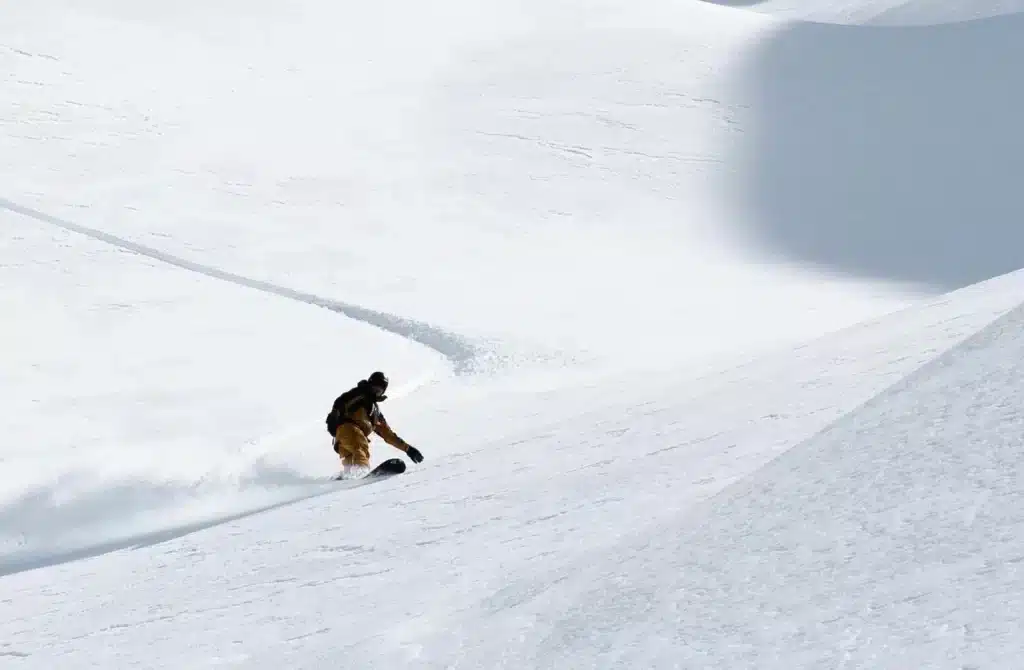
As March draws to a close, King Winter has already blessed the Alps with some stunning powder days over the past months. However, these perfect days were often fleeting, with warm spells even in the heart of winter. This yo-yo effect has become a frustratingly common occurrence in recent years.
These warmer temperatures might make you long for a summer adventure, perhaps something on your bucket list. You know the type – those “you only live once” experiences that often remain unfinished. Maybe a safari is on your mind? The problem is, our freeride hearts aren’t ready for summer just yet. Africa feels too far, and our hunger for powder is still too strong. If only there was a place where these desires could merge – a winter safari with abundant powder snow, less than 700 km from Brussels.
It sounds too good to be true, but there is such a place: Engelberg. As freeriders, this destination has always shone brightly on our bucket list. Engelberg has built a reputation over the past decades, especially among freeriders.
Expectations are high after all the tales and writings over the years, dubbing it the “Mecca for freeriders” and “the cradle of freeriding.” It’s high time to discover this winter safari adventure. We load our powder skis and freeride boards and head to Switzerland. What follows are days that freeriders dream of.
Arrival in Engelberg
After a drive of just under 6.5 hours, we arrive in Engelberg. Recently, fresh snow had fallen, but there’s no sign of it in the valley. The green landscape indicates that winter hasn’t visited for a while. Additionally, we’re greeted with quite a bit of rain – not the form of precipitation we had hoped for.
We check the weather forecast again. From tomorrow, it promises a few stunning sunny days, but the temperatures are too high! Before setting foot on Engelberg soil, doubts begin to arise in the car. Slightly worried jokes like, “I didn’t bring my swimsuit” or “Does everyone have a raincoat?” start flying around. These concerns would later prove unwarranted and disrespectful. Engelberg’s true treasures are, of course, not in the village below but up in the high mountains.
Everything Breathes Freeride
Our base for the coming days is the Bellevue-Terminus Hotel, a charming and centrally located 4-star hotel. Another iconic hotel in Engelberg is the Ski Lodge Engelberg, founded by two Swedish ski buddies who left their office jobs to fulfill their dream.
This dream has since grown into a legendary spot for freeriders. It’s the go-to place for Freeride World Tour athletes when they stay in Engelberg between competition events. During our visit for a cozy dinner, we meet two FWT pro riders staying at the hotel. Everything here breathes freeride.
We meet Sanne Mona, who joins us for a three-course Swedish-style meal. A Swede who arrived in Engelberg nine years ago and never left. Sanne now fills her winters as a pro skier, competing in 4-star FWT Qualifiers. Just last week, she was with the Mammut freeski team on the Titlis for a film shoot.
Stories are exchanged throughout the evening – from life as a competition skier to traumatic avalanche experiences and half-promises to go heliskiing in Russia someday. We also learn a lot about what makes Engelberg so unique and beloved among freeriders.
Snow Magnet
The record amount of snow that fell at Titlis Boden (2149 meters above sea level) in less than 72 hours is 205 cm. At the top of Titlis (3000 meters above sea level), snow depths typically reach around 350 cm, with peaks of up to 800 cm! But what makes Engelberg such a magnet for fresh powder snow? A quick geography lesson is in order.
The main factor influencing the weather in the Alps is the main Alpine ridge. This line of the highest mountains in the Alps runs from the Mediterranean Sea to eastern Austria. The ridge isn’t a straight line but a curve, affecting precipitation from the four wind directions. Moist air is forced to rise against the ridge, causing precipitation. If it’s cold enough, it snows.
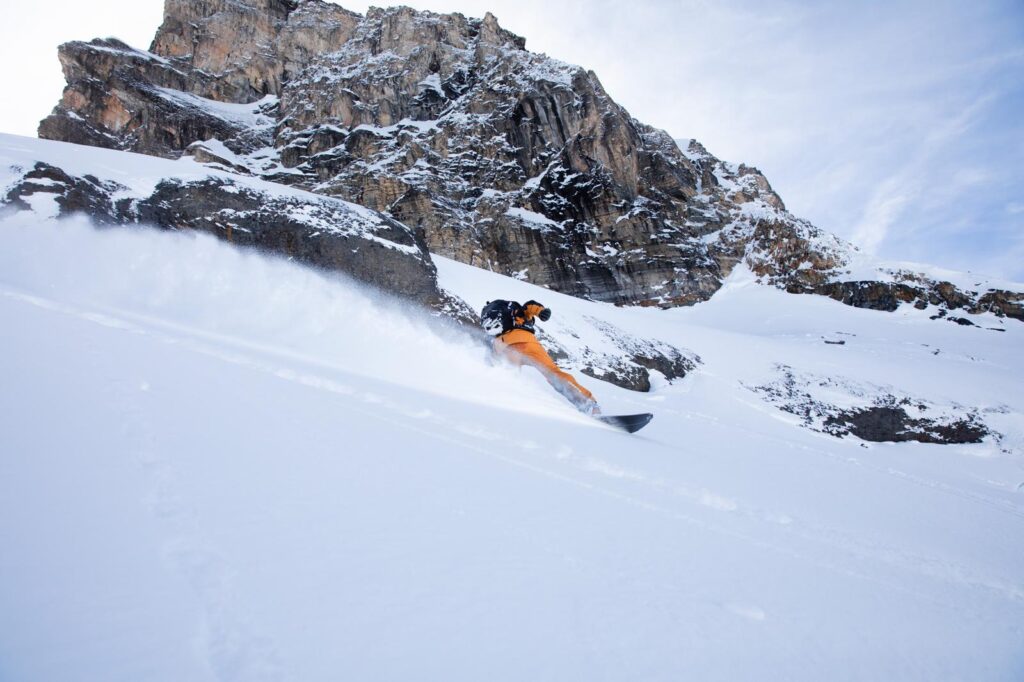
Engelberg’s unique geographic location distinguishes it from other ski areas. It lies close to the northern side of the main Alpine ridge, where clouds from the northeast to northwest are forced to rise abruptly over a short distance. These 3000+ meter giants create a wall that turns the smallest amount of moist air into precipitation. Imagine a storm from the north – you get snow, lots of snow!
Today, a heavy precipitation zone passed through. Unfortunately, it’s rain in the lower valley. But up in the Engelberg-Titlis ski area, which reaches up to 3028 meters, it’s a different story. With this new information, we have no choice but to believe Sanne Mona. Tomorrow could be fantastic. We wash away our last doubts with a beer in the cozy bar of Ski Lodge Engelberg and head back to our hotel. Tomorrow, a freeride safari awaits: The Big Five of Engelberg.
The Big Five of Engelberg-Titlis
The alarm goes off, and the curtains fly open. The weather gods do not disappoint with a bluebird, sun-soaked morning. Over breakfast, we finalize our plans for the day. We’re here on a mission: to ski the “Big Five.” Five iconic and challenging lines in and around the Engelberg-Titlis ski area. With “only” 55 km of slopes and 12 lifts, Engelberg isn’t the place for die-hard piste skiers on paper. But Engelberg is about quality over quantity. In reality, you ski long and challenging runs in a beautiful, snow-sure environment. What makes Engelberg-Titlis truly unique, however, is what’s beyond the pistes.
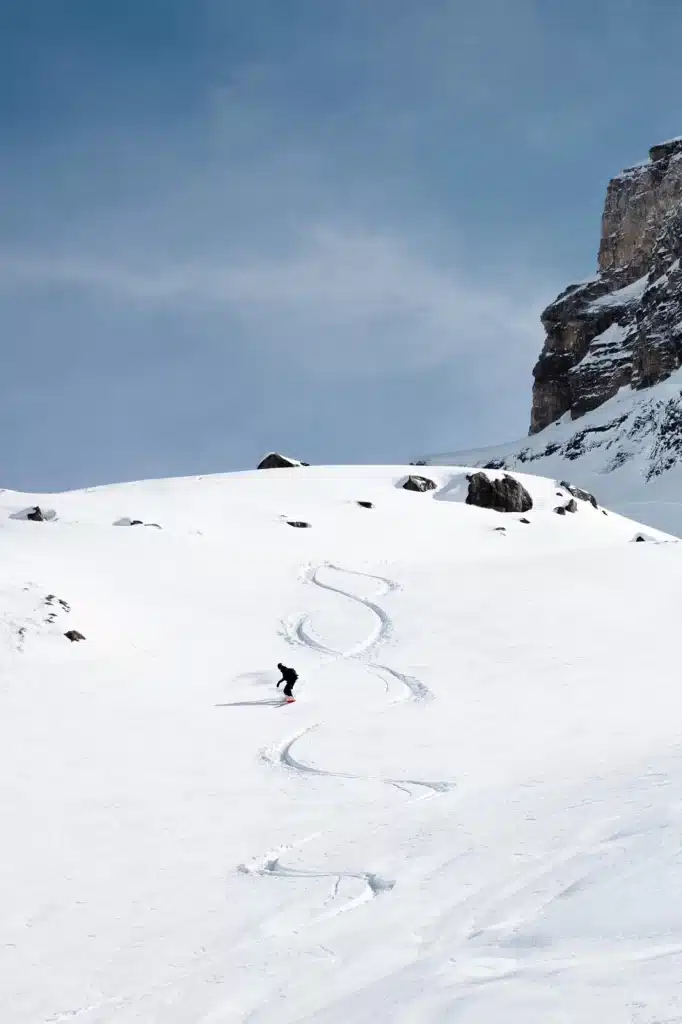
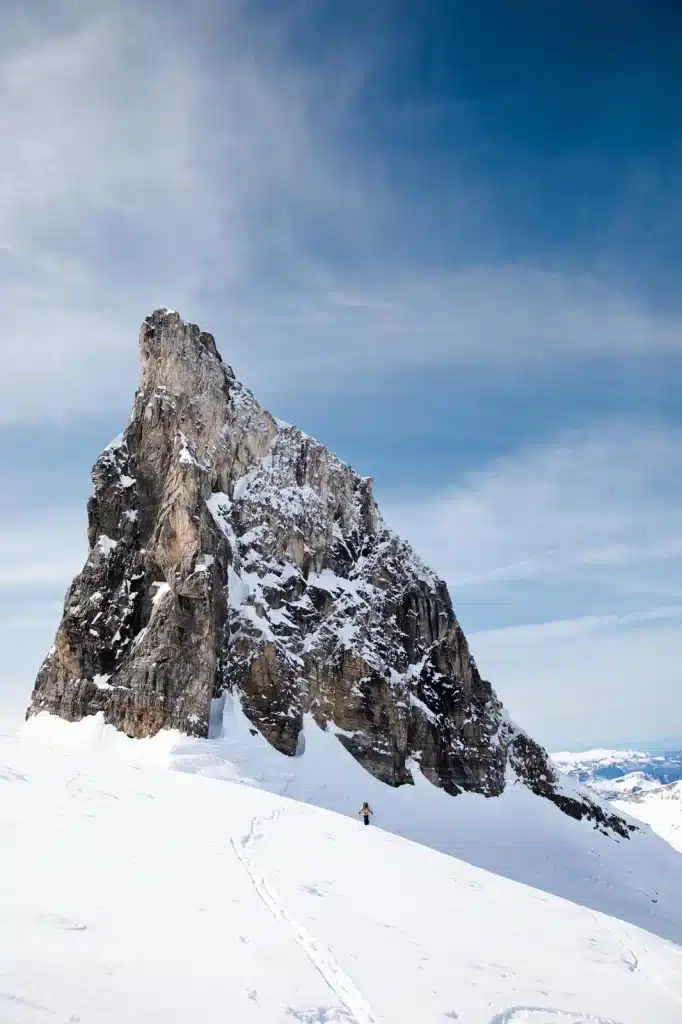
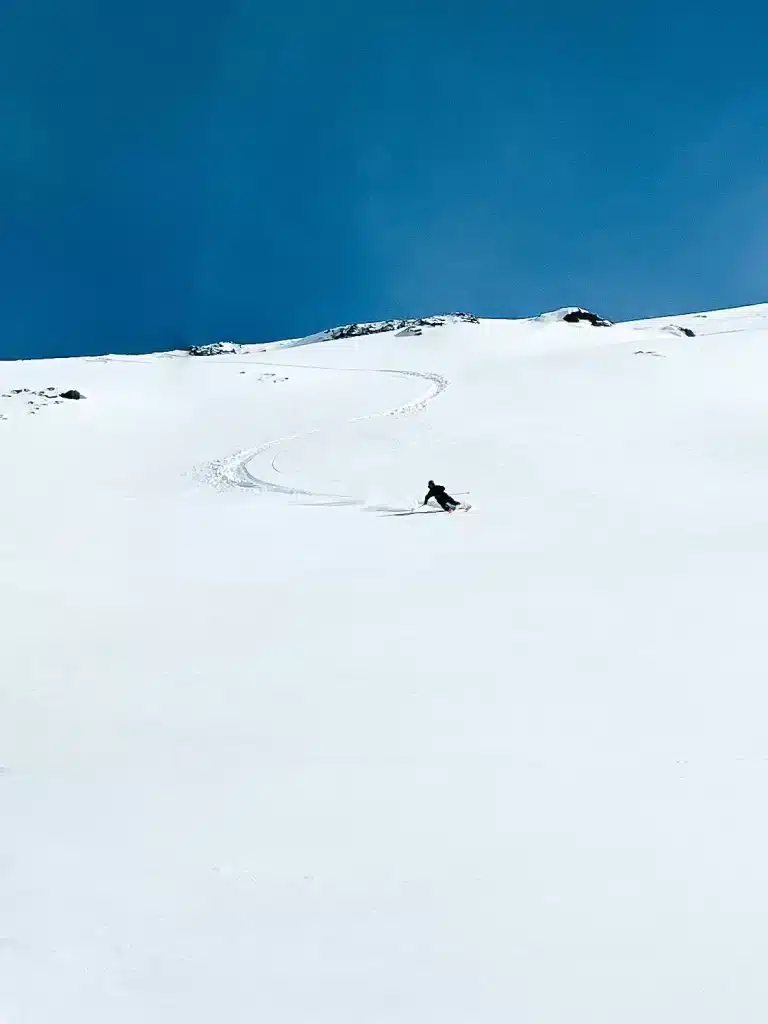
Visitors on safari in Africa aim to check the legendary “Big Five” off their lists: the elephant, lion, rhinoceros, buffalo, and leopard. Here in Engelberg, people are obsessed with a different kind of “Big Five.” This freeriders’ list includes the Laub, Galtiberg, Steinberg, Sulz, and Steintäli – all set to make any freerider’s heart race. Together, they cover about 5600 vertical meters of freeriding. Each descent is linked to an animal from the original “Big Five,” with more in common than it seems. The circle is complete, and we’re ready to start our freeride safari.
Time for Action
We meet our guide “Bernie” at the valley lift. A cheerful and friendly guy, Bernie will help us safely complete our mission. Although the “Big Five” are accessible from the lifts, they’re in high alpine terrain, bringing avalanche danger and hazards like crevasses and cliffs. A knowledgeable guide is a necessity here.
The Titlis Xpress takes us up. There, a different scene unfolds than in the valley. Fresh powder snow! Combined with bluebird skies and relatively few people, it’s the perfect setup.
We warm up on the piste but are soon lured to a beautiful powder spot. The first powder turns are a fact, with the green summer valley in the background. The contrast couldn’t be greater.
The Steinberg (The Rhinoceros)
Right to the point, the plan is clear: we’re heading for the first of the “Big Five” – the Steinberg or Rhinoceros. The Steinberg owes its name to its thick armor of ice and snow. We have 1200 vertical meters and 4.5 km of descent ahead towards Trübsee. It’s a wide flank with big lines and various options, some more challenging and risky than others. We choose a more challenging route. Bernie guides us through a section above large cliffs where falling isn’t an option. The avalanche danger is significant, and signs of a small slab avalanche keep us alert. Even a small slab can have serious consequences here. One by one, we descend until we’re past this “no-fall zone.” It’s clear we’re in the real deal, and this is freeriding at its best under perfect conditions of fresh powder and sun.
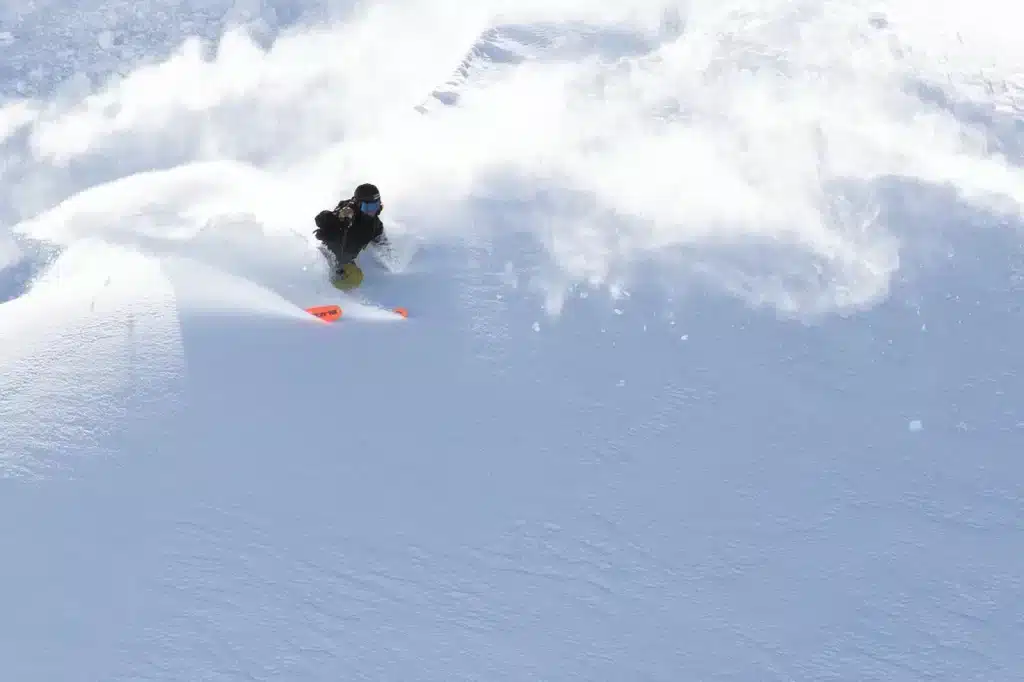
Looking around, it’s easy to see why this is called the Mecca for freeriders. The wide flanks attract many pro riders internationally. To the left, someone jumps off a high cliff, and to the right, a rider spins a double backflip off a wind lip. The freeride level here is high. Sharing the powder with a Freeride World Tour athlete is likely, but we don’t mind as long as they leave some for us.
We descend further towards Trübsee. The sun’s impact on the lower part of the Steinberg is evident, with the snow getting heavier. But it doesn’t matter; the first 1000 vertical meters of powder made up for it. We can tick off the first of the Big Five.
Snow Safety Training
We discussed with the guide and decided it would be useful to practice avalanche protocols. Even though we’re familiar with avalanche safety, there’s always something new to learn. One by one, we search for a backpack with a beacon buried in the snow. It’s quickly evident that mistakes in execution can cost valuable seconds. Bernie offers some great material “hacks” and tips to improve efficiency.
It’s time to refuel, so we return to Trübsee for lunch. The sun-drenched terrace provides a view of the entire Steinberg slope, a satisfying reflection on our morning’s skiing.
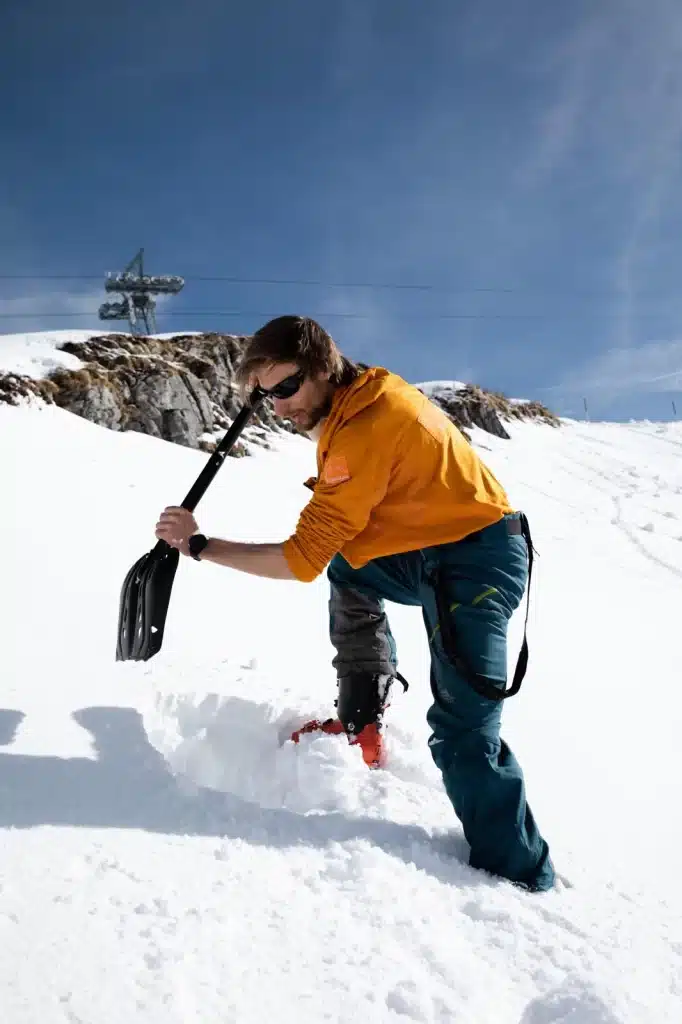
The Galtiberg
Our guide Bernie isn’t taking it easy on our first day. In the afternoon, we’re tackling the largest of the Big Five: the Galtiberg, also known as the Lion. Its 2000 vertical meters and 8km descent make it the king of Engelberg’s Big Five.
We head to the highest point of the ski area, over 3000 meters. Immediately after leaving the lift, we dive into the powder, starting our second Big Five descent.

Rarely have we felt so small, surrounded by majestic cliffs and couloirs. This is big mountain freeriding! As we descend, the snow quality decreases, forcing us to carry our skis on our backs to reach the other side of the mountain. We descend further until we reach the tree line, where the warm temperatures have melted the snow. We have to carry our skis and hike the remaining 800 vertical meters. The path is winding and technical, challenging even in regular shoes, let alone ski boots.
After about an hour of walking, we reach the valley. It’s a shame we couldn’t ski all the way down, but it was still a fitting end to our Galtiberg adventure. As the sun sets, a taxi waits to take us back to our hotel in Engelberg. Number two of the Big Five… check!
Freeride Pioneer
At our hotel, we are met by Geny Hess, a freeride pioneer and legend from Engelberg. He’s taking us for a culinary experience in Engelberg tonight. In recent years, Geny has also become a culinary expert. Meeting a freeride legend and culinary expert is a rare combo.
We enter the hotel bar and are greeted by a man with a white beard and hair. Admittedly, the association with freeriding isn’t immediately obvious. We suspect the evening will focus more on gastronomy than skiing. But once again, we’re wrong. Geny takes us to one of his favorite restaurants, where the evening becomes unforgettable.
Geny tells us stories of being the first to ski the challenging Galtiberg decades ago, shaping Engelberg into the freeride mecca it is today. Despite his white hair, he’s as lively and fit as a 25-year-old. Just last week, he was on the mountain with a Mammut film crew. We watch some footage; his old-school style and ability to ride powder are impressive. When asked about not wearing a helmet, he jokes, “My white hair is too beautiful for that.”
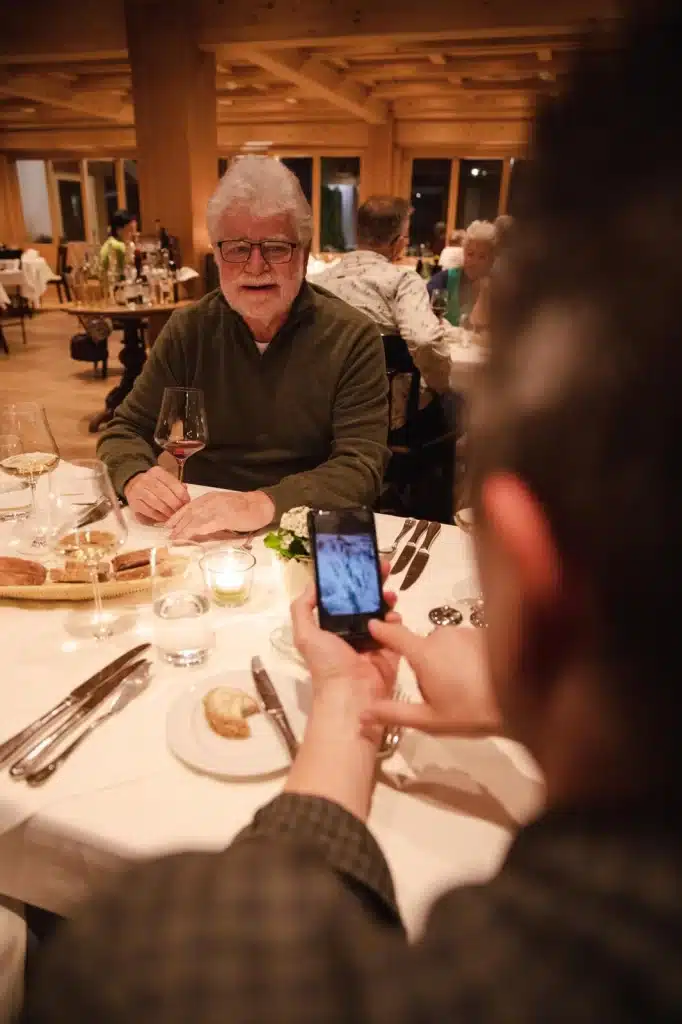
It’s an inspiring evening. We ask Geny for his secret to staying so active at 78. His answer is simple: “Nature formed me.” Living close to nature and spending time outdoors. His advice to younger freeriders: “Focus on the journey, not just the summit. There’s beauty between the valley and the peak.”
We leave Geny inspired, his words resonating with us and many future generations of freeriders.
The Leopard
Day two begins, and we meet Bernie at the cable car. Unfortunately, he’s delayed due to a severe fire 10 km from Engelberg, blocking traffic. The weather promises another “bluebird” day, making the wait in the morning sun pleasant. Bernie eventually arrives, and we head up.
We discuss the game plan. Three of the Big Five remain. However, the Laub, or Elephant, is not feasible due to insufficient snow. The Laub is the most famous of the five, with 1200 vertical meters and a steep start. Conditions must be ideal for safe skiing due to avalanche risks.
We move on to the Steintäli, also known as the Leopard. Its less frequent visibility lends to the comparison. The Steintäli offers 500 vertical meters and a 2km descent, smaller than the others. Bernie suggests we skin up to the small Wendestock, adding 500 extra vertical meters of powder fun.
After an hour’s climb, we reach the top. The powder is fluffy, making the climb worthwhile. We enjoy the view before descending through the best powder of the trip, deep and untracked. The descent with Engstlensee in the background is breathtaking, making us feel small amidst the big mountain scenery of Engelberg.
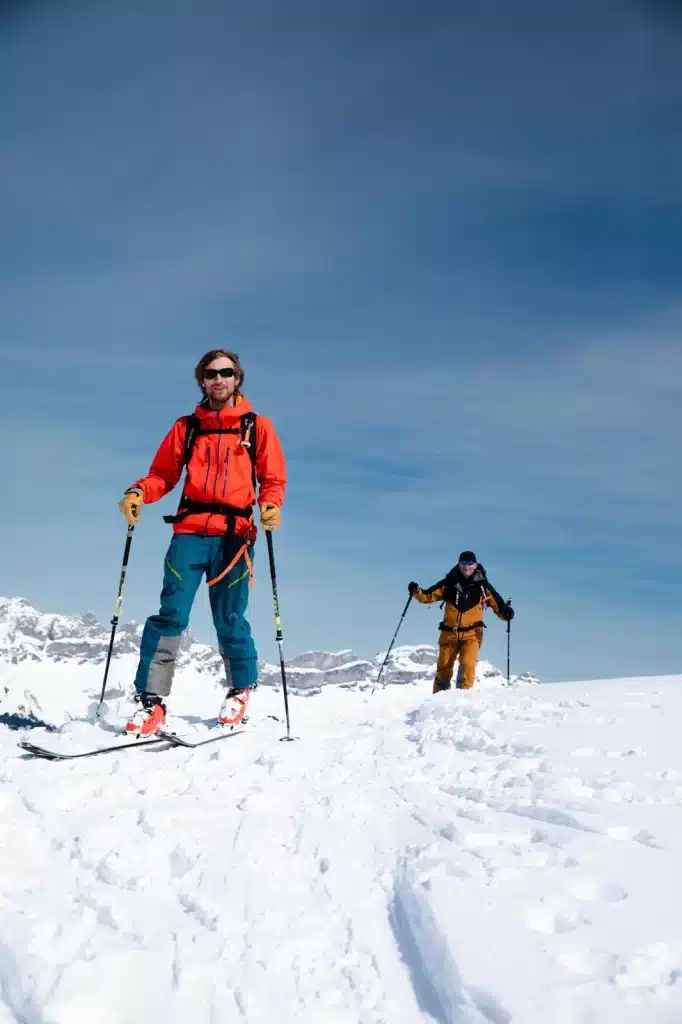
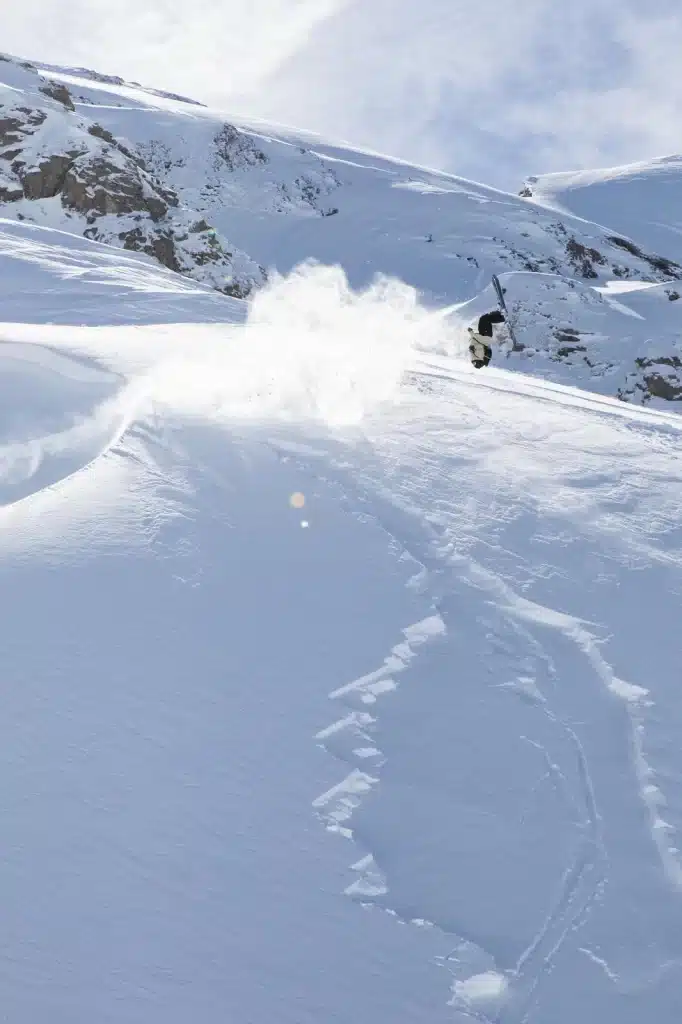
By late afternoon, we’re back down for lunch. One Big Five member remains: the Sulz, or Buffalo, with 700 vertical meters and a 2.4km length. The Sulz offers various options, from mellow powder turns to couloirs and cliff drops.
Over lunch, we discuss our plans. The temperature has risen, and the snowpack has become heavy. Bernie advises against the Sulz due to avalanche risks. We reluctantly agree.
We descend via the regular valley run to Engelberg. Our Big Five score: 3 out of 5. Not perfect, but still a success. Despite missing two descents, we’re all smiling. Remembering Geny’s words, “Focus on the journey,” we realize it’s about the experiences along the way.
We leave Engelberg with our freeride hearts full. The love for freeriding is palpable here. The many slopes we’ve yet to discover will surely bring us back. For now, we’re content with the journey.